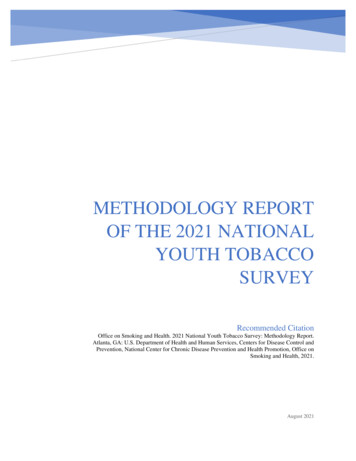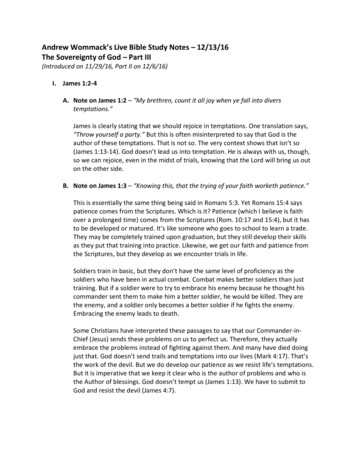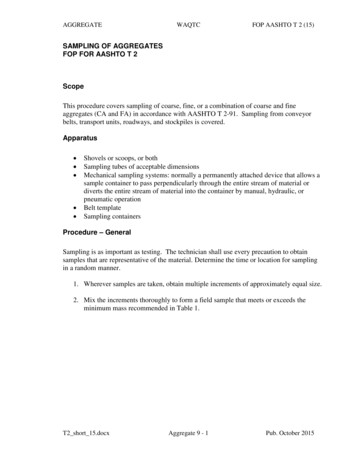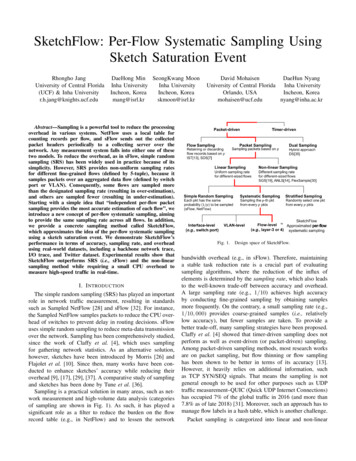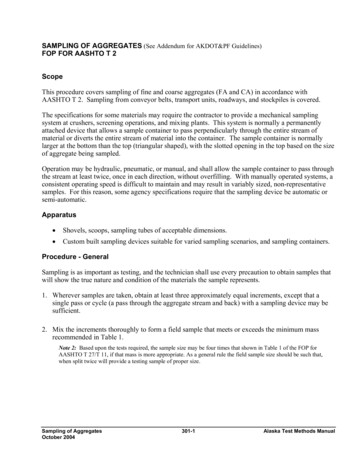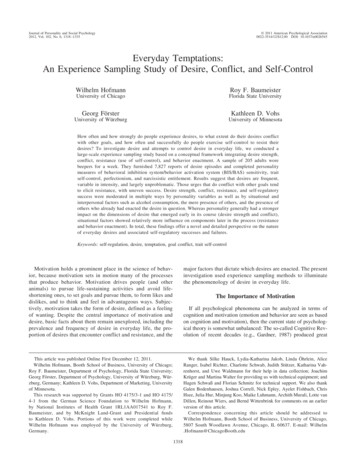
Transcription
Journal of Personality and Social Psychology2012, Vol. 102, No. 6, 1318 –1335 2011 American Psychological Association0022-3514/12/ 12.00 DOI: 10.1037/a0026545Everyday Temptations:An Experience Sampling Study of Desire, Conflict, and Self-ControlWilhelm HofmannRoy F. BaumeisterUniversity of ChicagoFlorida State UniversityGeorg FörsterKathleen D. VohsUniversity of WürzburgUniversity of MinnesotaHow often and how strongly do people experience desires, to what extent do their desires conflictwith other goals, and how often and successfully do people exercise self-control to resist theirdesires? To investigate desire and attempts to control desire in everyday life, we conducted alarge-scale experience sampling study based on a conceptual framework integrating desire strength,conflict, resistance (use of self-control), and behavior enactment. A sample of 205 adults worebeepers for a week. They furnished 7,827 reports of desire episodes and completed personalitymeasures of behavioral inhibition system/behavior activation system (BIS/BAS) sensitivity, traitself-control, perfectionism, and narcissistic entitlement. Results suggest that desires are frequent,variable in intensity, and largely unproblematic. Those urges that do conflict with other goals tendto elicit resistance, with uneven success. Desire strength, conflict, resistance, and self-regulatorysuccess were moderated in multiple ways by personality variables as well as by situational andinterpersonal factors such as alcohol consumption, the mere presence of others, and the presence ofothers who already had enacted the desire in question. Whereas personality generally had a strongerimpact on the dimensions of desire that emerged early in its course (desire strength and conflict),situational factors showed relatively more influence on components later in the process (resistanceand behavior enactment). In total, these findings offer a novel and detailed perspective on the natureof everyday desires and associated self-regulatory successes and failures.Keywords: self-regulation, desire, temptation, goal conflict, trait self-controlmajor factors that dictate which desires are enacted. The presentinvestigation used experience sampling methods to illuminatethe phenomenology of desire in everyday life.Motivation holds a prominent place in the science of behavior, because motivation sets in motion many of the processesthat produce behavior. Motivation drives people (and otheranimals) to pursue life-sustaining activities and avoid lifeshortening ones, to set goals and pursue them, to form likes anddislikes, and to think and feel in advantageous ways. Subjectively, motivation takes the form of desire, defined as a feelingof wanting. Despite the central importance of motivation anddesire, basic facts about them remain unexplored, including theprevalence and frequency of desire in everyday life, the proportion of desires that encounter conflict and resistance, and theIf all psychological phenomena can be analyzed in terms ofcognition and motivation (emotion and behavior are seen as basedon cognition and motivation), then the current state of psychological theory is somewhat unbalanced: The so-called Cognitive Revolution of recent decades (e.g., Gardner, 1987) produced greatThis article was published Online First December 12, 2011.Wilhelm Hofmann, Booth School of Business, University of Chicago;Roy F. Baumeister, Department of Psychology, Florida State University;Georg Förster, Department of Psychology, University of Würzburg, Würzburg, Germany; Kathleen D. Vohs, Department of Marketing, Universityof Minnesota.This research was supported by Grants HO 4175/3-1 and HO 4175/4-1 from the German Science Foundation to Wilhelm Hofmann,by National Institutes of Health Grant 1RL1AA017541 to Roy F.Baumeister, and by McKnight Land-Grant and Presidential fundsto Kathleen D. Vohs. Portions of this work were completed whileWilhelm Hofmann was employed by the University of Würzburg,Germany.We thank Silke Hauck, Lydia-Katharina Jakob, Linda Öhrlein, AliceRanger, Isabel Richter, Charlotte Schwab, Judith Stützer, Katharina Vahrenhorst, and Uwe Waldmann for their help in data collection; JoachimKrüger and Martina Walter for providing us with technical equipment; andHagen Schwaß and Florian Schmitz for technical support. We also thankGalen Bodenhausen, Joshua Correll, Nick Epley, Ayelet Fishbach, ChrisHsee, Julia Hur, Minjung Koo, Maike Luhmann, Archith Murali, Lotte vanDillen, Reinout Wiers, and Bernd Wittenbrink for comments on an earlierversion of this article.Correspondence concerning this article should be addressed toWilhelm Hofmann, Booth School of Business, University of Chicago,5807 South Woodlawn Avenue, Chicago, IL 60637. E-mail: Wilhelm.Hofmann@ChicagoBooth.eduThe Importance of Motivation1318
EVERYDAY TEMPTATIONSadvances in understanding cognitive processes, while motivationtheory has languished to some extent. Yet motivation is arguablymore fundamental than cognition, because motivation originates inthe basic drives to sustain life. Cognition (and emotion) likelyevolved to help organisms get what they need and desire—thus, toserve motivation. Despite its fundamental importance, basic factsabout motivation remain unknown, even in terms of how frequently human beings experience various desires and what proportion of desires are enacted. It is not even known whether desireis typical for most of waking life or instead only an occasionalphenomenon.Motivations can be understood as directing behavior towardobtaining satisfaction. However, not all desires can be enacted.Sometimes satisfaction is not available because of the environment, such as when plans are rejected or rained out. Extensiveconstraints attend social and cultural animals such as humankind.The requirements of living with others according to rules ofteninclude using self-control to restrain or redirect desires (e.g.,Baumeister & Exline, 1999; Freud, 1930; Hofmann, Friese, &Strack, 2009; Mischel, Cantor, & Feldman, 1996; Vohs & Ciarocco, 2004), especially insofar as rules shape how, when, andwhere individuals may satisfy various desires. The self-regulationof motivated behavior has been studied extensively in laboratories(e.g., Vohs & Baumeister, 2011), but relatively little is knownabout the frequency and effectiveness with which people successfully resist their desires in everyday life. The present investigationwas undertaken in part to provide such basic information. Specifically, we used experience sampling methods to investigate howoften and strongly desires are felt, how often they evoke conflictand resistance, and how often they are enacted versus inhibited. Aspecial focus of the present research was to illuminate how keypersonality traits (behavior activation and inhibition, self-control,perfectionism, and narcissistic entitlement) and situational factors(e.g., alcohol consumption, presence of others) would producedifferences in how strongly people experience desire and conflictand whether they would resist or enact those desires.Conceptual FrameworkOur strategy was based on the development of a four-stepmodel of motivated behavior. The framework integrates thecomponents of desire, conflict, resistance (use of self-control),and enactment. We define desire as an “affectively chargedcognitive event in which an object or activity that is associatedwith pleasure or relief of discomfort is in focal attention”(Kavanagh, Andrade, & May, 2005, p. 447). In plain terms,desire means wanting to have or do something. We assume thatdesires emerge from the interplay of triggering conditions in theenvironment and need states residing within the person(Baumeister & Heatherton, 1996; Finkel et al., 2011; Hofmannet al., 2009; Metcalfe & Mischel, 1999). Desires vary instrength and therefore in their potential to motivate behavior.Second, desires may or may not conflict with the person’svalues and goals. Conflict is the perception that there is somereason not to enact the desire and thus serves to distinguishunproblematic desires from problematic desires (i.e., temptations).In the case of unproblematic desires, enactment of the behavior isgenerally what people will strive for unless impeded by externalconstraints such as lack of opportunity. However, at times desires1319collide with other goals and standards, such as when one desirespie when on a diet or a nap during a tedious meeting. In accordancewith cybernetic and neural models of self-regulation, we assumethat the detection of a conflict is an important triggering mechanism for the third step of the framework, a person’s active effortsat resisting desire (Botvinick, Braver, Carter, Barch, & Cohen,2001; Carver & Scheier, 1982).Resistance, which we equate with the use of self-control, involves efforts to prevent oneself from enacting the desire. Weassume that the likelihood of resistance depends on the degree ofconflict experienced. The idea is that conflict is a signal that thereis a discrepancy or incompatibility between the person’s presentdesire and other higher order goals that needs to be resolved.Classic accounts of self-control posit that some sort of effortfulintervention (self-control, effortful control) is necessary in order tosolve such conflicts in the direction of goal-directed behavior.Hence the connection between conflict and enactment is bestconceptualized as mediated through the recruitment of self-control(resistance).1We hypothesized that whether the person enacts the desiredbehavior will be affected by the prior three steps: High desirestrength should increase the probability of behavior enactment.Conflict should be independent from desire strength and depend onpeople’s commitment to self-regulatory goals (i.e., goal importance). Where there is conflict, there often will be attempts to resistthe desire (Botvinick et al., 2001; Carver & Scheier, 1982). Resistance attempts should reduce the likelihood that the behaviorwill occur (Figure 1).Although most of these predictions may seem straightforward,the complexity of everyday life means at least that the size andprevalence of such effects would be open to question. We assumed, for example, that some behaviors may fail to be enacteddespite strong desire, low conflict, and low resistance; conversely,other desires may be enacted despite conflict and resistance, indicating self-regulatory failure (Baumeister & Heatherton, 1996).Self-regulation researchers usually do not measure strength ofdesire directly (for criticisms, see Hofmann et al., 2009; Hofmann,Gschwendner, Friese, Wiers, & Schmitt, 2008; Rawn & Vohs,2011). The present study assessed desire strength directly, whichtherefore allowed us to explore the interaction between desirestrength and resistance. We entertained two competing hypothesesabout this interplay. One was that resistance, in addition to havingan inhibiting main effect on enactment, would weaken the relationship between desire strength and enactment because the topdown act of resisting a desire may make people less susceptible toits motivational power. This hypothesis would imply a negativeinteraction term between desire strength and resistance. The otherpossibility was that desire strength would weaken the inhibitingmain effect of resistance on enactment because strong desires maybe harder to resist than weak ones—similar to the way in whichtaming a wild horse may be more difficult than taming a calmer1In this article, we restricted our analysis to active, effortful, intentional,and mostly conscious forms of self-regulation, but we acknowledge thatself-regulatory processes may also be triggered in the absence of a conscious intention and be carried out in a less effortful manner (Fishbach,Friedman, & Kruglanski, 2003).
1320HOFMANN, BAUMEISTER, FÖRSTER, AND VOHSFigure 1. Our four-step conceptual model of motivated behavior. Thecore of the model integrates desire strength, conflict, resistance (use ofself-control), and enactment. The lower pathway represents the basicassumption that desire strength instigates behavior enactment. The upperpathway represents the inhibiting influence of self-control, triggered by theexperience of conflict between a current desire and important other goals.External arrows indicate that each step in the model may be moderated bypersonality and situational factors.entitled to special treatment. Hence we predicted that the personality trait effects would be prominent in the early stages of thesequence, namely, by affecting desire and conflict.In contrast, external factors, such as mere presence of others andespecially the presence of people who are already indulging, wouldbe prominent in influencing resistance and enactment (the laterstages). Thus, personality would play a key role in initiating theurge and responses to it, and social circumstances might come intoplay later to thwart or facilitate the behavior implied by the urge.To be sure, two of the traits we studied (trait self-control andbehavioral inhibition) could be seen as more relevant to resistanceand enactment than desire and conflict, so we expected that therewould be shades of gray. Still, the general pattern we predictedwas that the strongest influences would shift from inner to outerones as one moved through the sequence from desire to conflict toresistance to enactment.Personality and Self-ControlBehavioral Activation and Inhibition Systemsone (see James, 1890/1950). This hypothesis would imply a positive interaction term between desire strength and resistance.One strength of our conceptual framework is that it can assesshow exactly a particular personality or situational factor affectsself-regulation. For example, a variable might increase conflict asa direct effect, which might then be passed along through resistance to enactment. In addition to pinpointing such main effects,the model also allowed us to test whether a certain variable affectsthe relationship between different steps in the model. We wereparticularly interested in identifying variables that moderate selfregulatory success, that is, the strength of connection betweenpeople’s attempts to resist a given desire and their enactment of thedesire-related behavior. In sum, one of the framework’s advantages was that it allowed for a fine-grained analysis of how variouspersonality and situational factors influence the self-regulation ofmotivated behavior.From Inner to OuterForeshadowing modern self-regulation theory, Freud (1933/1949) famously described the ego as the servant of two masters,namely, inner desires and external reality. The present investigation took seriously the view that motivated behavior is subject toinfluence from both inner and outer sources. The inner onesincluded personality traits. Relevant external factors included alcohol use, the presence of others (who make the situation socialand thereby introduce considerations such as norms, selfpresentational concerns, and accountability), and in particular thepresence of others who are doing what one desires to do.How each of these influences affects the self-regulation ofdesire may differ in accord with our conceptual framework. Wehypothesized that inner traits would be most influential in terms ofhousing the motivation and thus giving rise to desire. Of course,desire can and does arise from external forces (indeed, the prevalence and presumptive success of advertising is based on stimulating desires). But whether and in what manner an externalstimulus evokes desire or conflict likely will be affected by theperson’s internal traits, such as lacking self-control or feelingWe now turn to developing hypotheses concerning the specificpersonality traits we studied. Individual differences in acting onone’s desires are supposedly based on having a strong behavioralapproach or behavioral activation system (BAS), relative to theperson’s behavioral inhibition system (BIS; Gray, 1987, 1982).Metaphorically, the BAS can be compared to the engine of behavior, whereas the BIS is akin to the brakes. Carver and White (1994)developed scales to measure these separately.In terms of our model, we assumed that the BAS would exertinfluence at an earlier stage than the BIS. People with a strongerand more active BAS should exhibit stronger desires than others,and this should carry through to greater enactment of impulses. Incontrast, we expected people with a stronger and more active BISto enact their desires less frequently than others, an effect weassumed would be brought about by more frequent and moreeffective resistance among high BIS individuals.Trait Self-ControlBecause trait self-control is generally understood as the capacityto resist desire, we assumed that individual differences in selfcontrol would moderate some of the patterns of desire, but weentertained two competing sets of hypotheses. The first and mostobvious prediction was that people low in trait self-control wouldenact more conflicted desires than people high in trait self-control.Low self-control presumably reflects either low motivation or lowability to restrain oneself (or both), and so when faced with aconflicted desire, people low in self-control should be more likelythan others to act it out. The effect might occur because of lowerrates of resistance following conflict, which would mean thatpeople with low self-control simply do not try to restrain themselves when they have a conflicting desire. Alternatively, or additionally, behavior enactment might occur despite resistance, whichwould mean that people with low self-control try to restrainthemselves but ultimately fail to do so. Thus, the first mainprediction was that low self-control would result in a weakerinhibitory pathway from conflict to enactment (via resistance).Whether this stems from low motivation or low ability to control
EVERYDAY TEMPTATIONSoneself would be reflected in the specific stage at which the traitoperates.Recent work has, however, suggested a second, alternativeview, and indeed a sweeping reconceptualization of how traitself-control may operate in real life. A meta-analysis by de Ridderand colleagues (de Ridder, Lensvelt-Mulders, Finkenauer, Stok, &Baumeister, 2011) concluded that trait self-control may operatemore by way of establishing effective habits and routines than byresisting single temptations. In other words, people with goodself-control may avoid temptations rather than resisting them. Thisview implies quite different predictions from what we suggested inthe preceding paragraph: It may be the people with high rather thanlow self-control who find themselves not spending time and effortresisting temptations. Whether high self-control improves behaviorbecause of frequent and effective resistance to temptation or instead because of avoiding temptations (which consequently yieldslow rates of conflict and resistance) was thus a crucial focus of thiswork. The answers would point to dramatically different modelsfor how this trait ultimately influences everyday behavior.PerfectionismWhereas trait self-control has been shown to have largely adaptive and beneficial effects, indicating its function as a generallyhelpful trait, perfectionism can be regarded as a maladaptivetendency to misuse and thereby squander self-regulatory capabilities. Perfectionists are defined by setting and clinging rigidly tounrealistically high standards and unattainable goals (e.g., Frost,Marten, Lahart, & Rosenblate, 1990; Shafran & Mansell, 2001;Vohs et al., 2001). Perfectionism should therefore increase conflictfor the many desires that do not mesh with one’s standards. Higherconflict in turn should engender greater resistance and possiblylesser enactment as carryover effects.Narcissistic EntitlementThe concept of narcissism originated as a clinical diagnosis buthas become a focus of personality research, stimulated in part bya scale for measuring narcissism in nonclinical populations(Raskin & Terry, 1988) and the development of a scale specificallyfocused on narcissistic entitlement (Campbell, Bonacci, Shelton,Exline, & Bushman, 2004). Narcissistic entitlement reflects anattitude that one ought to have what one wants, presumably linkedto the sense that one is a special, superior person. Campbell et al.(2004) defined narcissistic entitlement as “a stable and pervasivesense that one deserves more and is entitled to more than others”(p. 31). Hence, we predicted that people high in narcissistic entitlement would be more likely than others to enact their desires.There was no reason to expect that they would have strongerdesires. We assumed, however, that they should be less likely thanothers to feel conflicted about their desires. This is because peoplehigh in entitlement may think that their own wishes are sufficientreason to act on them, and therefore they disregard potentialobjections and problems (stemming from conflict with other goalsor with external situational constraints). Reduced awareness ofpotential conflicts in the here and now may lead to less resistanceand, ultimately, more enactment.1321State and Situational FactorsAlcohol IntoxicationWe assessed level of alcohol intoxication, which can be seen asa psychological state that is a blend of inner and situationalinfluences. Competing hypotheses were entertained as to whetheralcohol would influence desire earlier or later in the sequence.With respect to the enactment of desire (i.e., whether the persondoes what was desired), the basis for expecting intoxication toexert an effect was clear and strong: Alcohol consumption hasbeen found to impair the power of self-control to inhibit inappropriate action tendencies (e.g., Fillmore & Vogel-Sprott, 1999;Hofmann & Friese, 2008; Steele & Southwick, 1985).As to whether alcohol might affect the strength of desire, thebasis for making predictions is less clear. A review by Steele andSouthwick (1985), for instance, concluded that alcohol does notcreate or stimulate desires but rather merely weakens the inhibitors. On that basis, one would predict no effect of alcohol on desireper se. Nonetheless, it is conceivable that alcohol renders desires tobe felt more strongly than they would be otherwise. For example,ample evidence indicates that alcohol intoxication increases thelevel of aggressive response to provocation but does not causeaggression in the absence of provocation (Bushman & Cooper,1990). These findings could indicate that the effect of alcohol islimited to whether the person inhibits aggressive impulses, butthey could also be interpreted as showing that intoxicated peoplebecome more upset and angry than sober ones in response toidentical provocations. The assessment of desire strength in thisstudy allows for us to test these two possible mechanisms.Social Factors: Presence of Other People and Presenceof Enactment ModelsWhether the presence of others has an inhibiting or facilitatingeffect on enactment of desire may depend on whether other peopleare merely present or whether other people are actively engagingin the desire-related behavior themselves, thus serving as enactment models. (Note that the term models is used here to denoteperforming behaviors that others might copy, à la Bandura, 1977,rather than statistical or mathematical modeling.)Regarding the presence of others, we speculated that otherpeople in one’s environment would generally constrain the perceived or actual options for action, thereby hindering the enactment of many desires. In addition, the presence of others mayincrease self-awareness (Duval & Wicklund, 1972) and therebymake the actor more aware of his or her standards, leading to moreresistance—particularly resistance to behaviors that conflict withother goals.We reasoned that the presence of enactment models wouldconstitute a special case that produces effects quite different fromthe mere presence of other people: Seeing others doing what onedesires to do may act as a basis for justification and may promoteindulgence through processes of motivated reasoning (Kivetz &Zheng, 2006; Kunda, 1990). Thus, enactment models should reduce resistance, possibly through a reduction of conflict. Furthermore, enactment models may serve as a particularly strong primeof behavioral action schemas in memory (e.g., Chartrand & Bargh,1999; Strack & Deutsch, 2004). Recent research suggests that
HOFMANN, BAUMEISTER, FÖRSTER, AND VOHS1322nonconscious perception– behavior priming may be particularlyimpactful when people are motivationally prepared for action(Cesario, Plaks, & Higgins, 2006). Therefore, we expected thatenactment models would lead to less resistance than would beotherwise and might also have a direct priming effect on enactmentthat is unmediated by a decrease in resistance.Other Situational FactorsWe also assessed the general location at which people hadexperienced their desire (e.g., home, work, public places). Weexpected that, on average, work and public settings would constitute more restraining environments than people’s homes; henceresistance—and perhaps experienced conflict, too—may be higherin those settings, and these effects should feed into lower rates ofenactment. In contrast, there was no reason to expect location toaffect desire strength.The Present ResearchExperience sampling is an expensive and labor-intensivemethod that allows researchers to learn about what people aredoing, thinking, and feeling at moments in their lives (e.g., Barrett& Barrett, 2001; Csikszentmihalyi & Larsen, 1987; Hektner,Schmidt, & Csikszentmihalyi, 2006). The present study recruitedan assorted sample of adults in a medium-sized European city(Würzburg, Germany) to wear beepers for a week. Each time thebeeper went off, they were asked to pause at what they were doingand report on what desires they felt at the moment and within thepast half hour. If they were having a desire, they reported on whatit was for, its strength, whether they felt conflict about it, whetherthey resisted it, and whether they enacted the desired behavior. Ina randomly selected subset of responses, participants also reportedon assorted facts relevant to the situation, such as whether otherswere present (and if so whether they were engaging in the desiredactivity), participants’ location, and whether they had consumedalcohol. As with all experience sampling studies, ours struggledwith the tradeoff between wanting a large amount of informationon each episode and yet wanting the task not to be so onerous thatcompliance would dwindle. The high compliance rates (below)and high quantity of good quality data suggested that our procedures struck a reasonable balance. To our knowledge, this study isthe first one that has used experience sampling methods to map thecourse of desire and self-control in everyday life.newspaper ads and a large participant pool mailing list. Experience sampling data from three participants were lost due totechnical problems. Hence, the final sample consisted of 205participants.ProcedureParticipants were provided with Blackberry pocket personaldata assistants (PDAs) during an orientation meeting. Duringthe meeting they were informed about the general purpose ofthe study, received both oral and written instructions on how touse the PDA, and provided informed consent. Furthermore, theywere informed about confidentiality as well as how their participation would be compensated. On the PDAs, a customizedJava ME application controlled the assessment schedule, questionnaire presentation, and data saving.Participants carried the PDAs with them during the experience sampling period of seven consecutive days. Each day,seven signals were distributed throughout a time window of 14hr. For each day, participants could personalize the beginningof the schedule to either 8 a.m., 9 a.m., or 10 a.m. Followingrecommendations of Hektner et al. (2009), this time windowwas divided into seven blocks of 2 hr; within each block, anexact signal time was randomly selected with the condition thattwo consecutive signals be at least 30 min apart. If the PDA wasturned off at the time of the signal, the program rescheduled thesignal at a later point in the present or next time block; but if thePDA was off until the next time block ended, the response wasrecorded as missing. If the PDA was on but participants did notrespond or stopped responding during assessment, the programclosed after 15 min and recorded only the collected data.Furthermore, to ensure a sufficient number of questionnairesper participant, the schedule was extended by (a maximum of)1 additional day if participants responded to only fewer thanfive signals on any 1 day. In that case (17% of participants), amessage popped up at the end of the day, kindly asking participants to carry the device for 1 more day. All participantscomplied with this request.Participants were reimbursed with 20 initially (approximately 28). As additional incentives, if they completed more than 80% ofsignals they received movie passes worth 15 ( 21) and participated in a raffle for one of two iPod Touch music players. Onaverage, participants responded to and completed 92.2% of signals. A small fraction (0.3%) of signals was only partially completed. The remaining 7.5% of signals were not responded to at all.MethodExperience Sampling DataParticipantsThe sample included 208 participants (66% female) from thecity of Würzburg, Germany, and its surroundings. Participantswere aged 18 to 55 (M 25.24, SD 6.32), and 73% wereuniversity students. The student part of the sample was heterogeneous, involving 49 different fields of study (e.g., n 13were psychology students). The remaining 27% of participantswere either full- or part-time employed (13.9%), currentlydoing an apprenticeship (3.4%), high-school students (1.9%),unemployed (1.4%), on maternity leave (1%), retirees (1%), orengaged in another role (4.3%). Participants were recruited viaThe experience sampling protocol consisted of two parts. Thefirst part asked about the main aspects of the desire episode as p
University of Chicago Roy F. Baumeister Florida State University Georg Förster University of Wu rzburg Kathleen D. Vohs University of Minnesota How often and how strongly do people experience desires, to what extent do their desires conflict with other goals, and how often and successfully do people exercise self-control to resist their desires?

